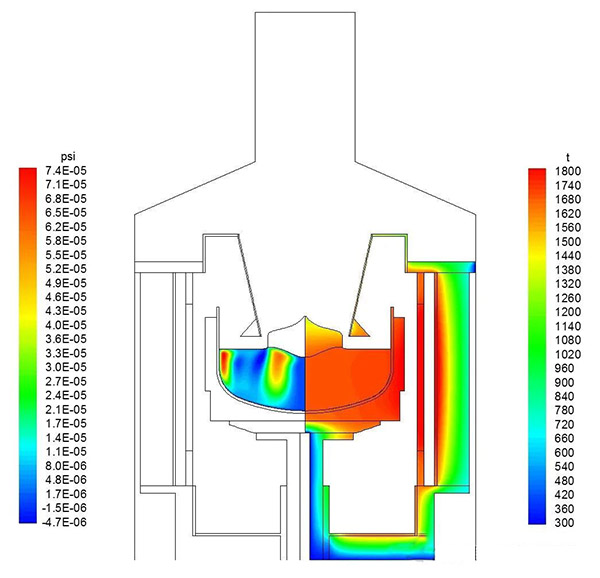
- English
- Español
- Português
- русский
- Français
- 日本語
- Deutsch
- tiếng Việt
- Italiano
- Nederlands
- ภาษาไทย
- Polski
- 한국어
- Svenska
- magyar
- Malay
- বাংলা ভাষার
- Dansk
- Suomi
- हिन्दी
- Pilipino
- Türkçe
- Gaeilge
- العربية
- Indonesia
- Norsk
- تمل
- český
- ελληνικά
- український
- Javanese
- فارسی
- தமிழ்
- తెలుగు
- नेपाली
- Burmese
- български
- ລາວ
- Latine
- Қазақша
- Euskal
- Azərbaycan
- Slovenský jazyk
- Македонски
- Lietuvos
- Eesti Keel
- Română
- Slovenski
- मराठी
- Srpski језик
What is Thermal Field?
2024-08-27
In the field of single crystal growth, the temperature distribution within the crystal growth furnace plays a critical role. This temperature distribution, commonly referred to as the thermal field, is a vital factor that influences the quality and characteristics of the crystal being grown. The thermal field can be categorized into two types: static and dynamic.
Static and Dynamic Thermal Fields
A static thermal field refers to the relatively stable temperature distribution within the heating system during calcination. This stability is maintained when the temperature inside the furnace remains consistent over time. However, during the actual process of single crystal growth, the thermal field is far from static; it is dynamic.
A dynamic thermal field is characterized by continuous changes in temperature distribution within the furnace. These changes are driven by several factors:
Phase Transformation: As the material transitions from a liquid phase to a solid phase, latent heat is released, which impacts the temperature distribution within the furnace.
Crystal Elongation: As the crystal grows longer, the surface of the melt decreases, altering the thermal dynamics within the system.
Heat Transfer: The modes of heat transfer, including conduction and radiation, evolve throughout the process, further contributing to the changes in the thermal field.
Because of these factors, the dynamic thermal field is an ever-changing aspect of single crystal growth that requires careful monitoring and control.
The Solid-Liquid Interface
The solid-liquid interface is another crucial concept in single crystal growth. At any given moment, every point within the furnace has a specific temperature. If we connect all the points within the thermal field that share the same temperature, we obtain a spatial curve known as an isothermal surface. Among these isothermal surfaces, one is particularly significant—the solid-liquid interface.
The solid-liquid interface is the boundary where the solid phase of the crystal meets the liquid phase of the melt. This interface is where the crystal growth occurs, as the crystal forms from the liquid phase at this boundary.

Temperature Gradients in Single Crystal Growth
During single crystal silicon growth, the thermal field encompasses both solid and liquid phases, each with distinct temperature gradients:
In the Crystal:
Longitudinal Temperature Gradient: Refers to the temperature difference along the length of the crystal.
Radial Temperature Gradient: Refers to the temperature difference across the radius of the crystal.
In the Melt:
Longitudinal Temperature Gradient: Refers to the temperature difference along the height of the melt.
Radial Temperature Gradient: Refers to the temperature difference across the radius of the melt.
These gradients represent two different temperature distributions, but the most critical one for determining the crystallization state is the temperature gradient at the solid-liquid interface.
Radial Temperature Gradient in the Crystal: Determined by longitudinal and transverse heat conduction, surface radiation, and the crystal’s position within the thermal field. Generally, the temperature is higher at the center and lower at the edges of the crystal.
Radial Temperature Gradient in the Melt: Primarily influenced by the surrounding heaters, with the center being cooler and the temperature increasing towards the crucible. The radial temperature gradient in the melt is always positive.
Optimizing the Thermal Field
A well-designed thermal field temperature distribution should satisfy the following conditions:
Adequate Longitudinal Temperature Gradient in the Crystal: It must be sufficiently large to ensure that the crystal has enough heat dissipation capacity to carry away the latent heat of crystallization. However, it should not be excessively large, as this could hinder crystal growth.
Substantial Longitudinal Temperature Gradient in the Melt: Ensures that no new crystal nuclei form within the melt. However, if it is too large, dislocations may occur, leading to crystal defects.
Appropriate Longitudinal Temperature Gradient at the Crystallization Interface: It should be large enough to create the necessary supercooling, providing sufficient growth drive for the single crystal. However, it must not be too large to avoid structural defects. Meanwhile, the radial temperature gradient should be as small as possible to maintain a flat crystallization interface.
Semicorex offers high-quality parts in thermal field for semiconductor industry If you have any inquiries or need additional details, please don't hesitate to get in touch with us.
Contact phone # +86-13567891907
Email: sales@semicorex.com




